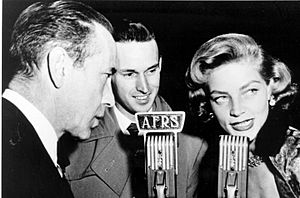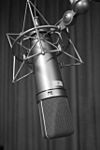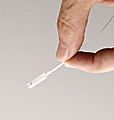Microphone facts for kids
A microphone, often called a mike or mic, is a cool device that changes sound into an electrical signal. Think of it like a translator for sound!
Microphones are super useful in many places. You'll find them in telephones, tape recorders, hearing aids, and when making movies. They are also key for audio engineering (which is about recording and mixing sound), in radio and television broadcasting, and in computers for recording your voice.
Contents
The History of Microphones
For a long time, people needed ways to make their voices louder so more people could hear them. The very first tools for this were like giant funnels called acoustic megaphones. In ancient Greece, around 500 BC, actors in outdoor amphitheatres used masks with horn-shaped mouth openings. These masks helped make their voices louder.
In 1665, an English scientist named Robert Hooke tried something different. He made a "lovers' telephone" using a stretched wire with a cup at each end. This showed that sound could travel through things other than just air.
Later, in 1876, Alexander Graham Bell invented his telephone. It used a "liquid transmitter" which had a rod in an acid solution. While it worked, the sound quality was not very good.
The First Good Microphones
The first microphone that truly worked well for talking on the telephone was the carbon microphone. This was invented by David Edward Hughes in England, and also by Emile Berliner and Thomas Edison in the US. Even though Edison got the first patent, many historians believe Hughes showed his working device earlier.
The carbon microphone was a huge step forward! It led to the telephones, radio, and recording we know today. Thomas Edison made it even better in 1886. This improved carbon microphone was used for the first ever radio broadcast, which was a performance at the New York Metropolitan Opera House in 1910.

In 1916, E.C. Wente created the first condenser microphone. Then, in 1923, the first useful moving coil microphone was made. This type became a standard for BBC studios in London.
Also in 1923, the ribbon microphone came out. These microphones were improved over the years, especially by RCA, making them better at picking up sound from a specific direction. As movies and TV became popular, there was a need for microphones that could capture clear sound and focus on certain sounds. Electro-Voice created their famous shotgun microphone in 1963, which was great for this.
In the second half of the 1900s, microphones kept getting better. Companies like Shure Brothers made popular microphones like the SM58 and SM57. Today, new research is even looking into using light, like fibre optics and lasers, to make microphones.
Kinds of Microphones
Sound travels through the air in waves. A microphone's job is to change these sound waves into electrical waves. Different types of microphones do this in different ways.
- Carbon button
- This was one of the first common types, used in most telephones in the 1900s.
- When sound waves hit a piece of carbon, they squeeze and release it. This changes how much electric current flows through a wire, creating electrical waves.
- This type became less common later because it didn't offer very high fidelity (clear sound).
- Dynamic
- This microphone uses a round plastic or rubber disk connected to a wire coil.
- When sound waves hit the disk, it vibrates. This vibration moves the coil back and forth very quickly near a magnet.
- This movement creates an electrical current.
- A dynamic microphone works the opposite way of a speaker. A speaker uses electricity to move a coil, which moves a disk, and then the disk makes sound.
- Condenser
- This type uses two small metal plates placed very close to each other.
- Electricity flows through these plates, creating an electric field between them.
- When sound hits the plates, they vibrate. These vibrations cause tiny changes in the electric field.
- These small changes create the electrical signal.
- Ribbon
- This microphone is a bit like a dynamic microphone.
- It has a thin, small sheet of metal (often tin or aluminum) hanging between two magnets.
- When sound hits this thin metal piece, it vibrates.
- This vibration then creates an electrical signal in the metal.
- Crystal or ceramic
- These microphones use something called piezoelectricity. This means certain crystals or ceramics can create a small electrical charge when they are squeezed or vibrated by sound.
Equipment for Microphones
When people record in a recording studio, they often use a pop filter (also called a pop shield). This is a special filter that helps stop or reduce 'popping' sounds. These popping sounds happen when fast-moving air, like from someone's mouth when they say "p" or "b" sounds, hits the microphone.
Related pages
- Loudspeaker — This device works in the opposite way of a dynamic microphone!
Images for kids
-
David Edward Hughes invented a carbon microphone in the 1870s.
-
Patti Smith singing into a Shure SM58 (dynamic cardioid type) microphone
-
Western Electric double button carbon microphone
See also
 In Spanish: Micrófono para niños
In Spanish: Micrófono para niños


























